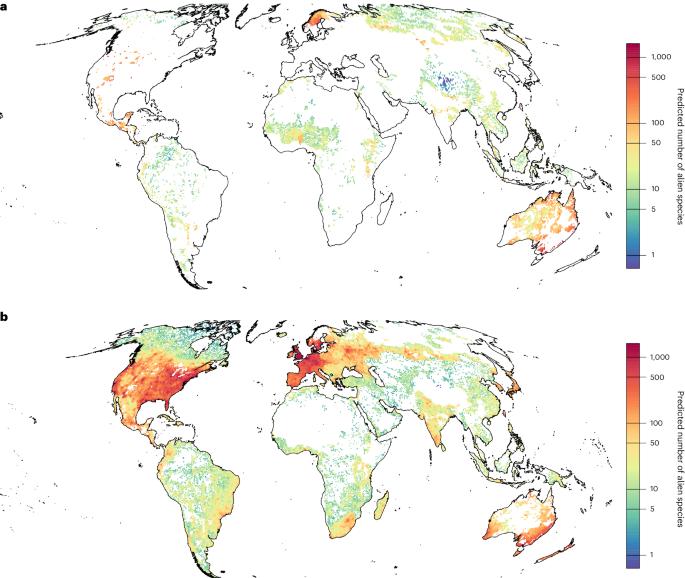对土著人民土地的生物入侵
IF 25.7
1区 环境科学与生态学
Q1 ENVIRONMENTAL SCIENCES
引用次数: 0
摘要
在高度相互关联和全球化的世界中,生物入侵是一个日益严峻的挑战,导致本土生物多样性的丧失。原住民土地(IPLs)通过土地管理和管理实践等活动,在生物多样性保护方面发挥着至关重要的作用。与保护区类似,它们也往往地处偏远,与国际贸易网络的联系较少。IPL 在多大程度上受到入侵物种扩散的威胁仍是未知数。在此,我们提供了一份全球研究报告,详细介绍了外来物种在 IPL 上的分布和驱动因素。在控制采样强度后,IPL上外来物种的数量平均比其他土地少30%(绝对数量:11 ± 3.5)。即使考虑了交通便利性和生态完整性差异等潜在的干扰因素,IPL 上的外来物种数量仍然持续较低。这种差异可能是土著居民的土地管理方式造成的。在相对较少的情况下,IPL 上的外来物种数量比其他土地高得不成比例,最有可能的原因是由于靠近大型城市地区,外来物种的繁殖压力较大。总之,我们的研究结果凸显了 IPL 在面对日益严重的生物入侵时保护自然的重要性。原住民土地(IPLs)是生物多样性的重要宝库;然而,这些土地在多大程度上受到全球日益增多的生物入侵的影响仍是未知数。本研究评估了土著人民土地与全球其他土地相比是否蕴藏较少的外来物种。本文章由计算机程序翻译,如有差异,请以英文原文为准。

Biological invasions on Indigenous peoples’ lands
Biological invasions are a growing challenge in a highly interconnected and globalized world, leading to the loss of native biodiversity. Indigenous peoples’ lands (IPLs) play a vital role in biodiversity conservation through activities such as land stewardship and management practices. Similar to protected areas, they are also often remote, with fewer connections to international trade networks. The extent to which IPLs are threatened by the spread of invasive species is still unknown. Here we provide a global study detailing the distribution and drivers of alien species on IPL. On average, IPLs host 30% (in absolute numbers: 11 ± 3.5) fewer alien species relative to other lands, after controlling for sampling intensities. Alien species numbers remained consistently lower on IPLs even after accounting for potentially confounding factors such as differences in accessibility and ecological integrity. The difference may result from land management practices of Indigenous peoples. In the relatively small number of cases where IPLs host disproportionately higher numbers of alien species than other lands, the most likely reason is high alien species propagule pressure arising from proximity to large urban areas. Overall, our results highlight the importance of IPLs in protecting nature in the face of increasing biological invasions. Indigenous peoples’ lands (IPLs) are important reservoirs of biodiversity; however, the extent to which these lands are affected by the growing number of biological invasions worldwide is still unknown. This study evaluates whether IPLs harbour fewer alien species compared with other lands globally.
求助全文
通过发布文献求助,成功后即可免费获取论文全文。
去求助
来源期刊

Nature Sustainability
Energy-Renewable Energy, Sustainability and the Environment
CiteScore
41.90
自引率
1.10%
发文量
159
期刊介绍:
Nature Sustainability aims to facilitate cross-disciplinary dialogues and bring together research fields that contribute to understanding how we organize our lives in a finite world and the impacts of our actions.
Nature Sustainability will not only publish fundamental research but also significant investigations into policies and solutions for ensuring human well-being now and in the future.Its ultimate goal is to address the greatest challenges of our time.
 求助内容:
求助内容: 应助结果提醒方式:
应助结果提醒方式:


